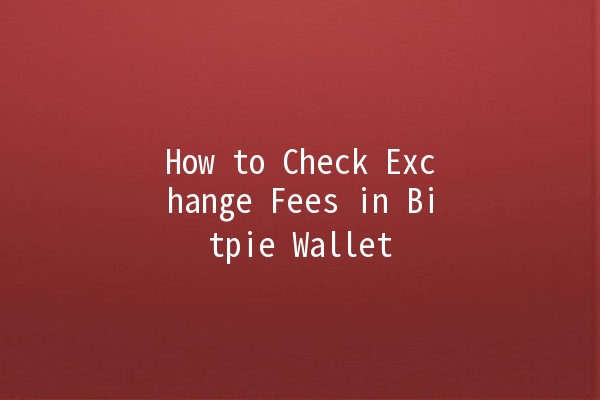
In the world of cryptocurrency, understanding transaction fees is crucial for managing your assets effectively. Among various wallets, Bitpie has gained popularity due to its userfriendly interface and robust security features. One critical aspect that users need to consider is the exchange fees associated with transactions. This article will explore how to check these fees in the Bitpie wallet, and provide actionable tips to enhance your cryptocurrency management productivity.
Understanding Exchange Fees in Cryptocurrency

Exchange fees are charges applied by wallets or exchanges when converting one cryptocurrency to another. These fees can vary based on several factors, including the type of transaction, the cryptocurrencies involved, and the wallet or exchange’s policies. Ignoring these fees can lead to unexpected losses, making it essential for users to stay informed.
How to View Exchange Fees in Bitpie Wallet
Viewing exchange fees in the Bitpie wallet is a straightforward process. Here’s a stepbystep breakdown:
Example of Exchange Fees in Action
Imagine you want to swap 1 BTC for ETH. The Bitpie wallet shows an exchange rate of 20 ETH per BTC, with a 1% exchange fee. Upon confirming the transaction, you would effectively receive 19.8 ETH due to the fee deducted from your swap.
Tips for Managing Exchange Fees in Bitpie Wallet
To optimize your cryptocurrency transactions, here are five practical tips you can apply:
Before making any exchange, it’s important to check the current market rates for cryptocurrencies. Prices can fluctuate significantly, and knowing the latest rates allows you to time your transactions better. You can use market tracking websites or apps to monitor price changes even while using Bitpie.
Setting price alerts can help you act quickly when your target exchange rates are met. Bitpie might not have this feature, but you can use external apps to get notifications on price changes for specific cryptocurrencies. This way, you can swap at the best possible rates and minimize fees.
Fees can change based on the network conditions and Bitpie's policies. Make it a habit to review these fees regularly. Understanding when fees are higher or lower can help you strategize better for your trades.
If you frequently make small transactions, consider consolidating them into larger ones. Many small exchanges can accumulate higher fees, while larger transactions may incur lower percentages. This approach reduces the overall fees you end up paying.
Some wallets and exchanges offer lower fees when transactions are made using their native tokens. Check if Bitpie provides such options and, if so, consider using them to reduce your fees significantly.
Possible Issues to Watch Out For
As you navigate through the Bitpie wallet, be mindful of common pitfalls:
Hidden Fees: Sometimes, fees may not be immediately apparent. Ensure to read the fine print before confirming transactions.
Network Congestion: During high traffic periods, fees can increase. Always monitor network conditions before executing trades.
Incorrect Exchange Rates: Rates can change rapidly; confirm them right before closing transactions.
FAQs About Checking Exchange Fees in Bitpie Wallet
Exchange fees are charges applied when you convert one cryptocurrency to another. They can include a percentage of the transaction, as well as flat fees imposed by exchanges or wallets.
While it’s not possible to entirely avoid exchange fees, you can minimize them through strategic trading, selecting lowfee times, and using native tokens where applicable.
Yes, there are typically two types of fees: trading fees (for currency exchanges) and withdrawal fees (for moving cryptocurrencies out of the wallet). Be aware of both when using Bitpie.
Fees can change based on various factors including network conditions and Bitpie's own policies. It's advisable to check the fees regularly as they may differ frequently.
If your account balance is insufficient to cover the fees, the transaction will likely not go through. Always ensure you have a little extra in your wallet to accommodate potential fees.
Most wallets, including Bitpie, provide transaction history that may include details about fees. You can review past transactions to analyze what fees you have incurred.
By understanding how to check exchange fees in the Bitpie wallet and applying the provided productivity tips, you can effectively manage your cryptocurrency investments and optimize your trading experience. The key to successful trading lies in knowledge and strategic execution, so stay informed and proactive in your approach.

